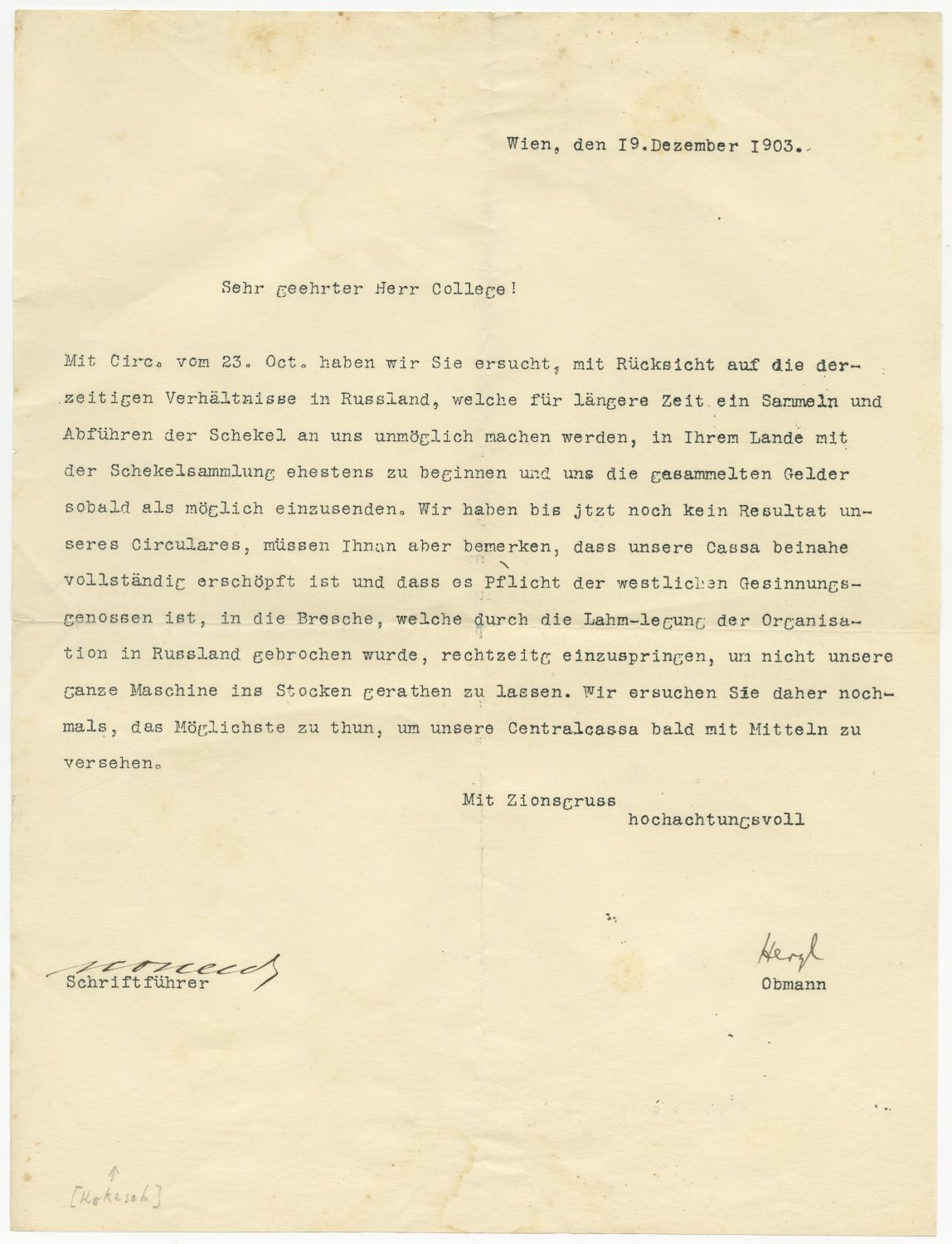
A letter signed by Theodor Herzl which was sent to To the Zionist leadership in Vienna regarding the collection of the shekels in Russia. Vienna, December 1903. Typewriter and Herzl's signature. German.
In his letter, Herzl asks that in view of the tense situation in Russia, to collect the shekels for the Zionist movement soon:
"We asked you, due to the current situation in Russia ... to collect the shekels in your country as soon as possible and send us the money collected", despite the difficulty. Herzl expresses concern that due to the various restrictions, Zionist propaganda may be stopped and urges him to act vigorously on the matter, and hopes that some help will come from the West. Herzl's letter appears a few months after the Kishinev riots when the situation of the Jews in Russia was difficult, and the Zionist movement was persecuted by the authorities.
[1] leaf. 28X21 cm. Very good condition.
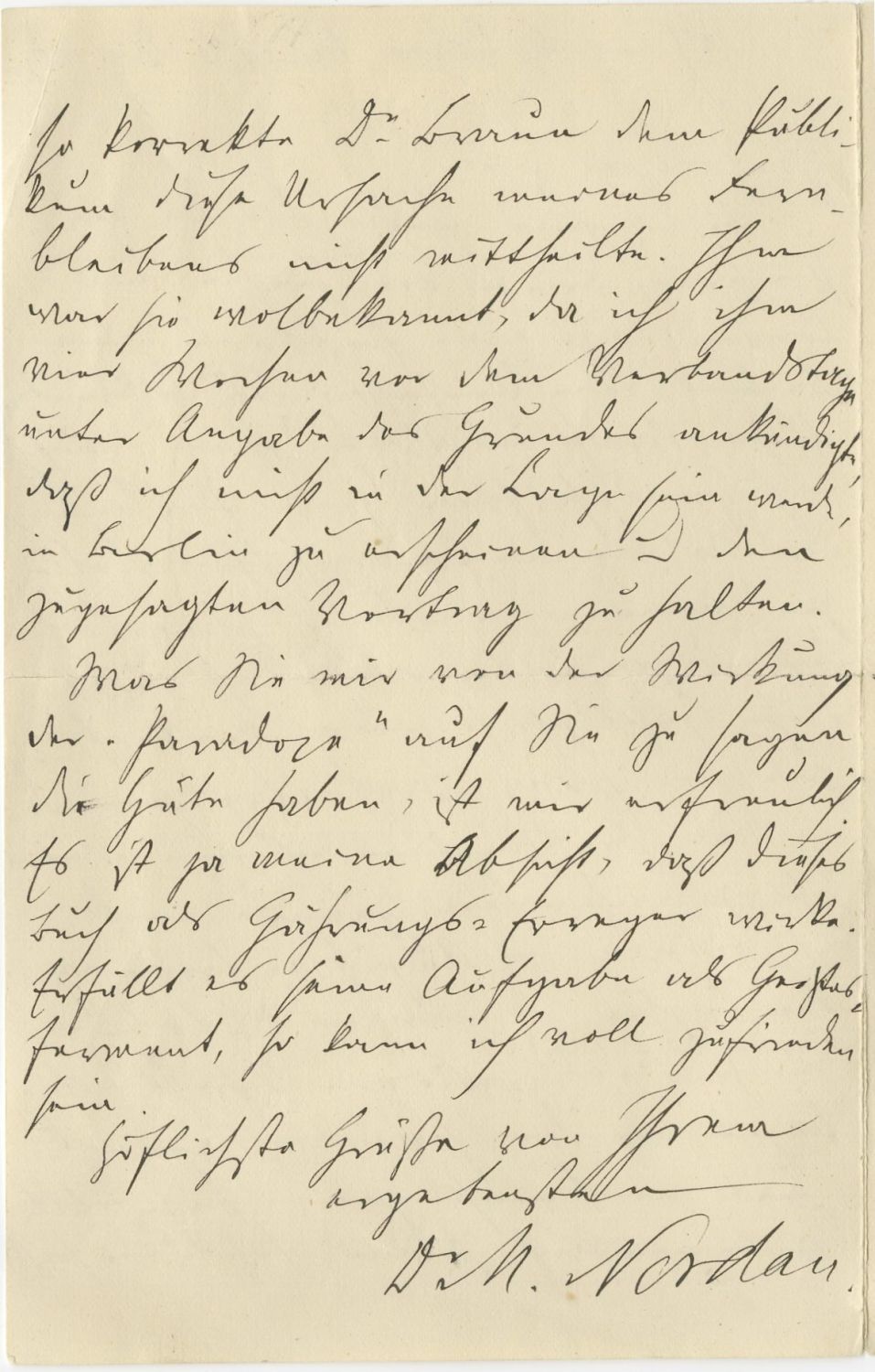
Letter in his handwriting and signature of Max Nordau from his early days, before joining the Zionist movement and becoming known mainly as a thinker. Paris, December 6, 1889.
Content of the letter: Nordau addresses the 'Dear Sir' (without mentioning his name) and promises that he will attach to it the letters of Hinzel and Herschler - both authors of books. And apologizes for not being able to obtain the manuscripts from the two, because he has no connection with their circle. He apologizes for not coming to Berlin to meet with the public because he had typhoid fever, adding that he does not understand why the public was not informed of the reason for his absence, even though he announced his expected absence in time. Nordau goes on to ask how much public influence there is by an essay he has published (he does not mention the name of the book), and what are the reactions to his book.
During this period Nordau established as a great thinker, especially in the fields of society, religion, and art, and his articles, in which he sharply criticized the hypocrisy and degeneration of contemporary European culture, often provoked many controversies. In 1892, Nordau became acquainted with Benjamin Zeev Herzl and the ideas of Zionism, and was soon drawn to the Zionist ideal.
[2] pages. 18x11 cm. Very good condition.

Letter in the handwriting and signature of David Wolfson, President of the World Zionist Organization - on a postcard with a photograph of Wolfson himself. Sent by mail to Germany to Max Schatz (to his residence in Bonn) on December 2, 1906. In his remarks, Wolfson writes his impression of where he was: "Greetings to everyone from the Golden City, I have never seen so many wonderful things" and greetings to Fanny Schatz.
David Wolfson [1856-1914] leader and Zionist activist and second president of the World Zionist Organization. After attending a speech by Max Bodenheimer on the revival of the Jewish people, Wolfson began his own speeches on Zionism. Within a short time Wolfson joined the leading activists in the German Hibbat Zion movement and became to a leading influencer. The tremendous impression left on him by the book "The Jewish State" of Herzl caused Wolfson to go to Vienna and become close friend and personal assistant of Herzl. After returning from Vienna, Wolfson established in koln the nucleus that would become the Zionist Organization in Germany - the National Jewish Association. Wolfson designed the Israeli flag inspired by the prayer shawl, and also gave the Zionist shekel his name.
[1] Postcard - written on both sides in Wolfson's handwriting. Good condition.

Letter in the handwriting and signature of David Wolfson, President of the World Zionist Organization. On the front of the postcard, Ephraim Moshe Lillian's work "Shirat Bat Zion" Sent by mail to Bon (Germany) to Haney (Fanny) Schatz in December 1902. "Dear Honey, I hope you have found your son in peace, and that in the meantime you have calmed down. I feel bad again, I sweated a lot, but the cough is almost gone."
David Wolfson [1856-1914] Zionist leader and activist and second president of the World Zionist Organization. After attending a speech by Max Bodenheimer that dealt with the revival of the Jewish people, Wolfson began giving his own speeches on Zionism. Wolfson soon joined the leading activists in the German Hibat Zion movement and became to a leading influencer. The huge impression left on her by Herzl's book The State of the Jews made Wolfson go to Vienna and become Herzl's close friend and personal assistant. After returning from Vienna, Wolfson established in Cologne the nucleus that would become the Zionist Organization in Germany - the "National Jewish Association". It was Wolfson who designed the Israeli flag inspired by the tallit, and it was he who gave the Zionist shekel its name.
[1] Postcard (Phonix Publishing). Very good condition.
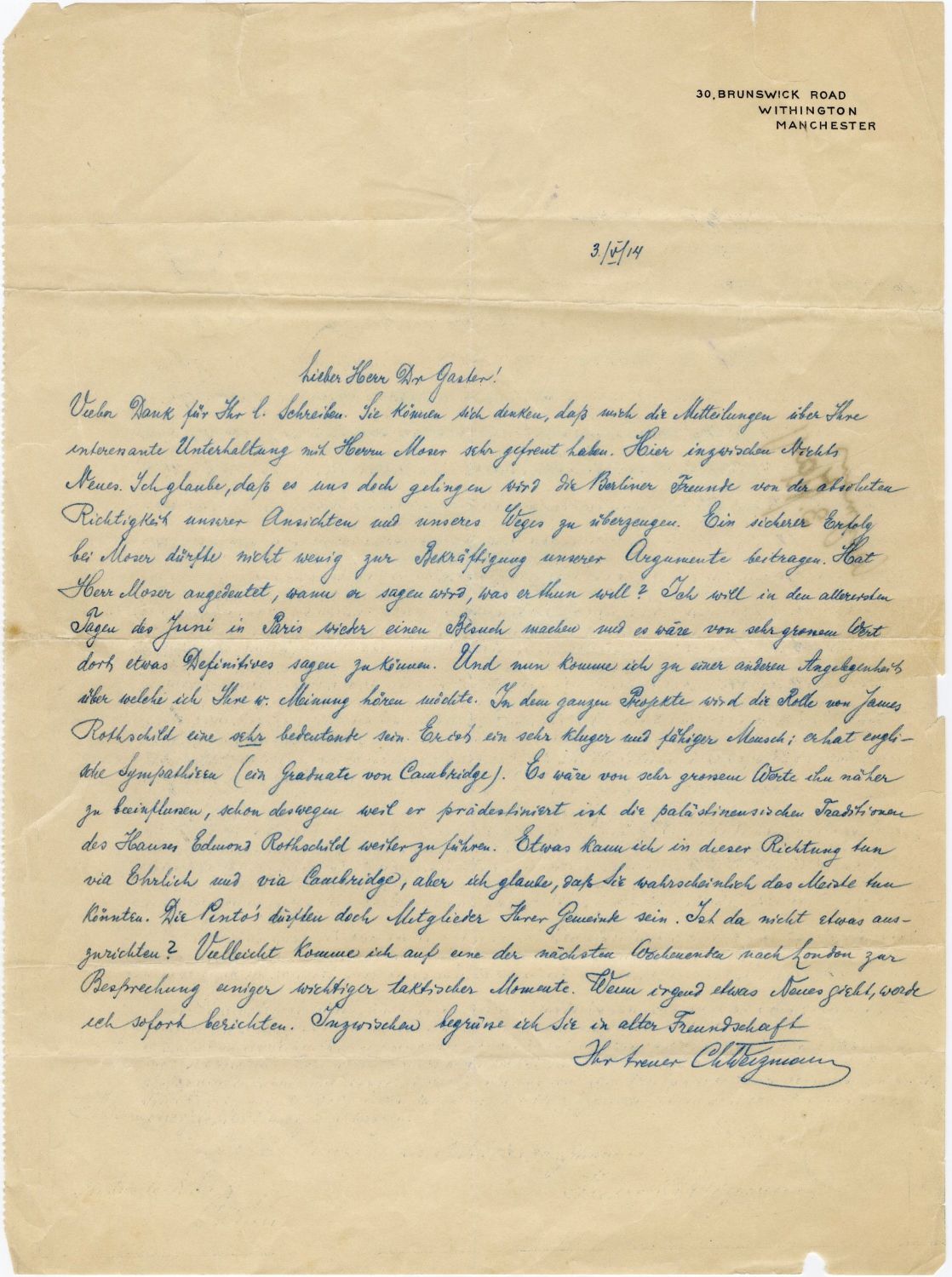
Early letter in the handwriting and signature of Chaim Weizmann to Dr. Moshe Gaster, leader of Romanian and British Zionism. May 30, 1914.
Weizmann and Dr. Gaster were good friends, and there was fruitful cooperation between them in advancing the Zionist interest. (The signing of the Balfour Declaration and its delivery to Weizmann took place at Dr. Gaster's home).The letter deals with the promotion of Zionist activity by the important community leaders in London. In his letter, Weizmann thanks him for his previous letter, adding that he was happy to hear about the negotiations with Eidelman Mussar, and that "it would be possible to convince the members of Berlin in our views". And asks if he already knows what a Eidelman Mussar intends to speak in the speech he was supposed to deliver. Towards the end of the letter, Weizmann writes that in June he intends to travel to Paris to give a speech, and consults with him on how can Baron James de Rothschild be made financially supportive in light of his ties to England Jewry, and whether assistance can also be obtained from the Pinto family, and concludes that he intends to come to London soon to the place of Gaster's seat, for further co-operation.
In February 1907, Weizmann was elected vice president of the Zionist Organization of England. At that time, He tried to attract Jewish capitalists to the Zionist enterprise. And on January 3, 1914, he first met Baron Edmund James de Rothschild at his home in Paris. At the end of December he again visited Edmund, who assured Weizmann of his support and introduced him to Lord Barty, the British Ambassador to France. Thanks to his connections with the Rothschild family, in August 1915 Weizmann also became acquainted with Lord Robert Cecil, who was then Deputy Minister of Foreign Affairs. From 1915 to 1916, after Weizmann himself moved to London, he developed social ties with influential families, thanks to whom he also made contact with groups of politicians, government officials, journalists and academics, and even tried his hand at receiving direct assistance from the British government.
The recipient of the letter is Dr. Moses Gaster (1856-1939), one of the leaders of Romanian and British Zionism, a Jewish public figure born in Romania, a sage of the Spanish community of London. Since he was involved and active in the Hovevei Zion movement in Romania, Dr. Gaster naturally participated enthusiastically in the political Zionist movement from its inception. Founded and headed the England Zionist Federation. Following the greatness of his admiration to Herzl, for one of his children he called "Theodor Herzl." During the First World War, he took part in negotiations with the British authorities regarding the establishment of a national home for the Jewish people in the Land of Israel, negotiations that led to the "Balfour Declaration." which was signed and delivered to Weizmann at Gaster's home.
[1] leaf. 29x21 cm. Folding marks. Good condition.
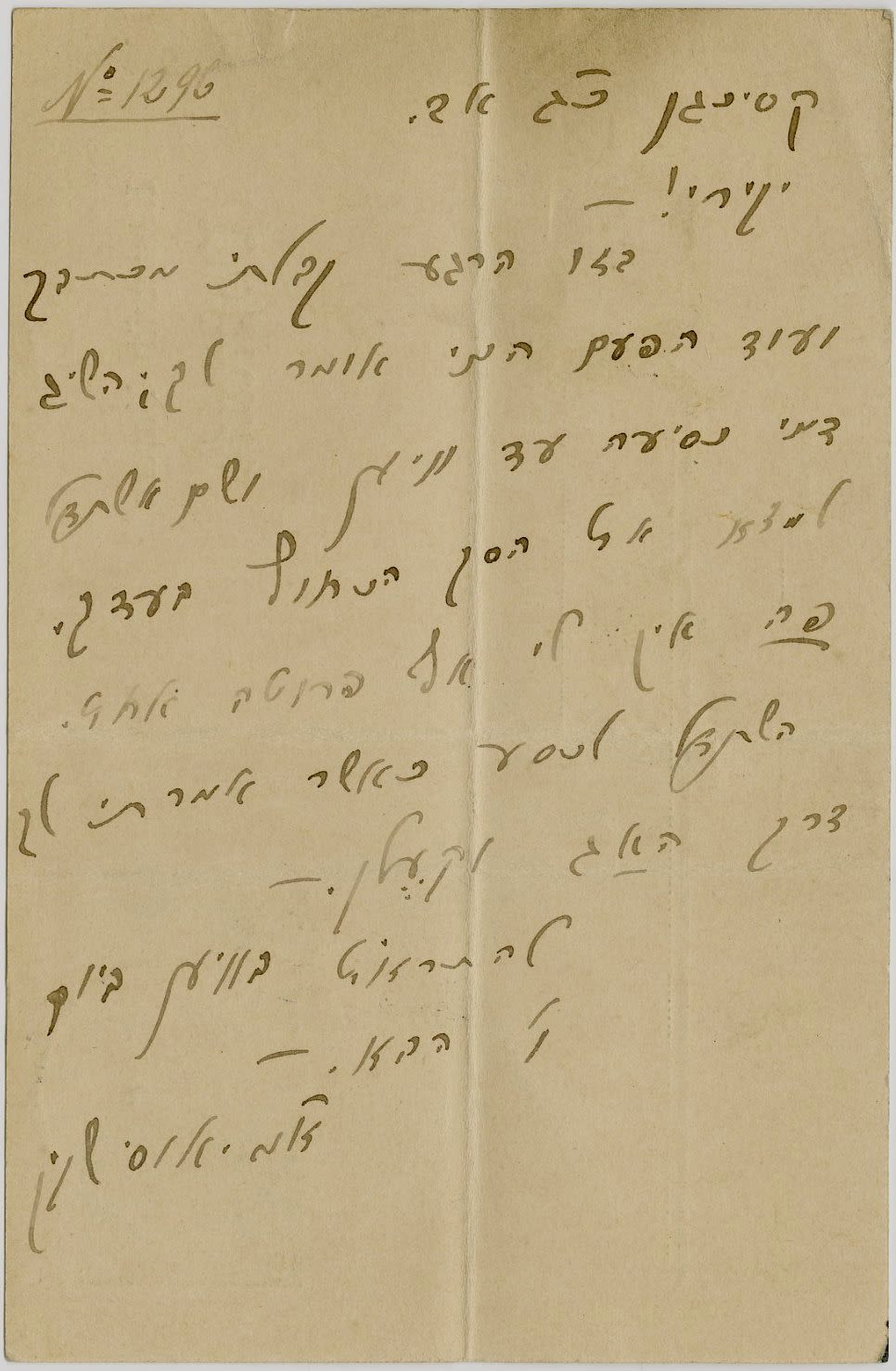
A postcard in the handwriting and signature of Menachem Ussishkin was sent to Chaim Weizmann from Kissingen (Germany) to Manchester (England) on August 6, 1904, about a month after Herzl's death.
Although the two great Zionist leaders were at the height of their public activity (in those days Ussishkin headed the committee that purchased land in the Land of Israel and sold it to private individuals, Weizmann headed the information department of the Zionist faction in Geneva) their economic situation was difficult. The two planned to meet about a week later in Vienna. Ussishkin asks Weitzman to get the fare to Vienna on his own, and in Vienna he will try to help him with the amount he needs, because in his place in Germany he does not have a single penny! And advises him to make the route to Vienna via The Hague and Cologne.
[1] Postcard. Folding marks. Good condition.
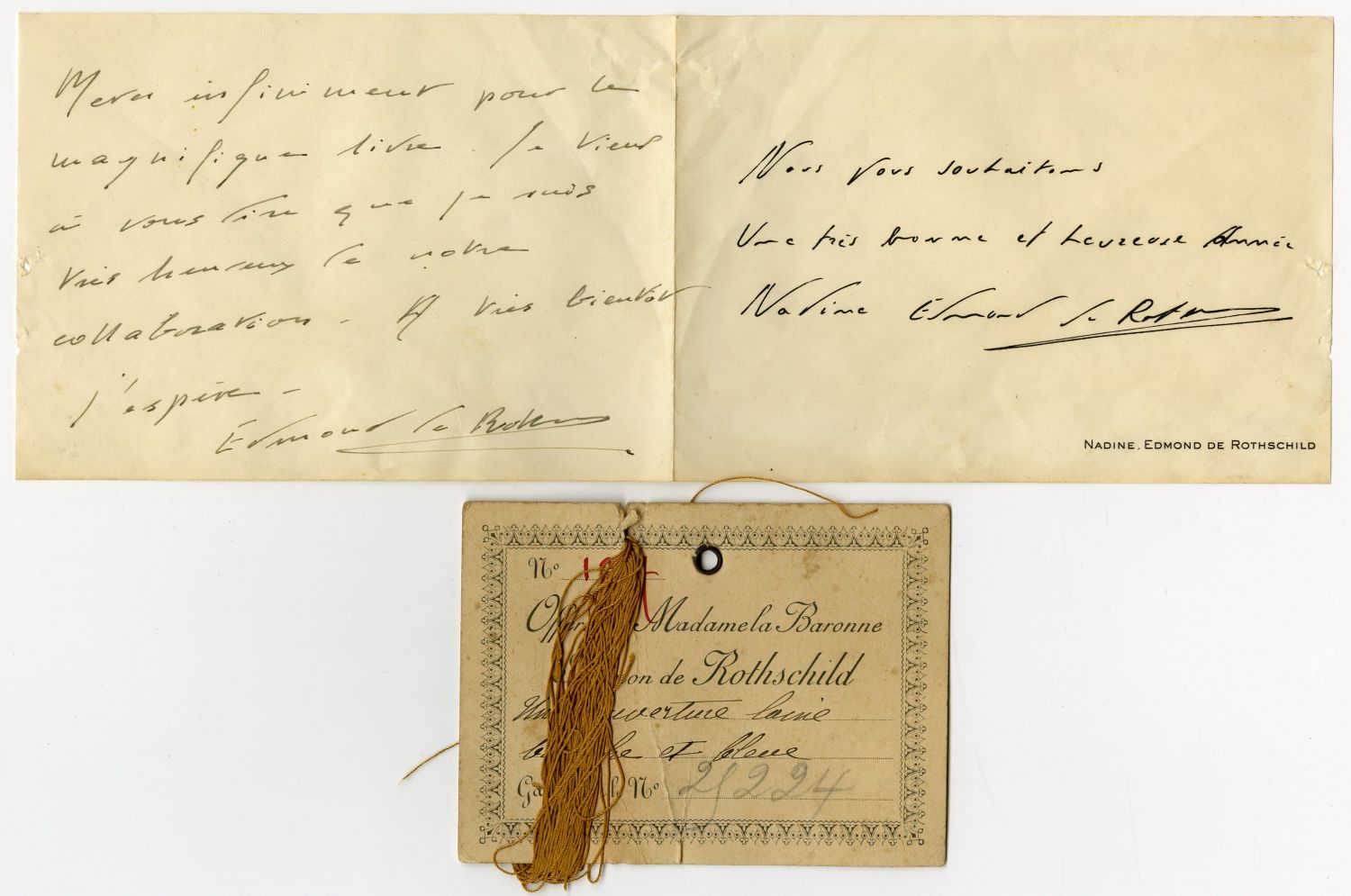
* Letter of thanks in the handwriting and signature of Edmond James de Rothschild, with the addition of a few lines of a 'Happy New Year' greeting in the handwriting of his wife Nadine de Rothschild.
* Business card of Solomon de Rothschild's wife with handwritten fill.
Baron Benjamin Edmund James de Rothschild [1845-1934], a member of the French branch of the Rothschild family, a philanthropist and Zionist, was a major supporter of the Jewish community in Eretz Israel during the First Aliyah. Known as "the well-known benefactor" and "the father of the settlement". In Israel. the nickname 'Baron Rothschild' usually refers to him, although there were other barons in the Rothschild family.
general condition very good.
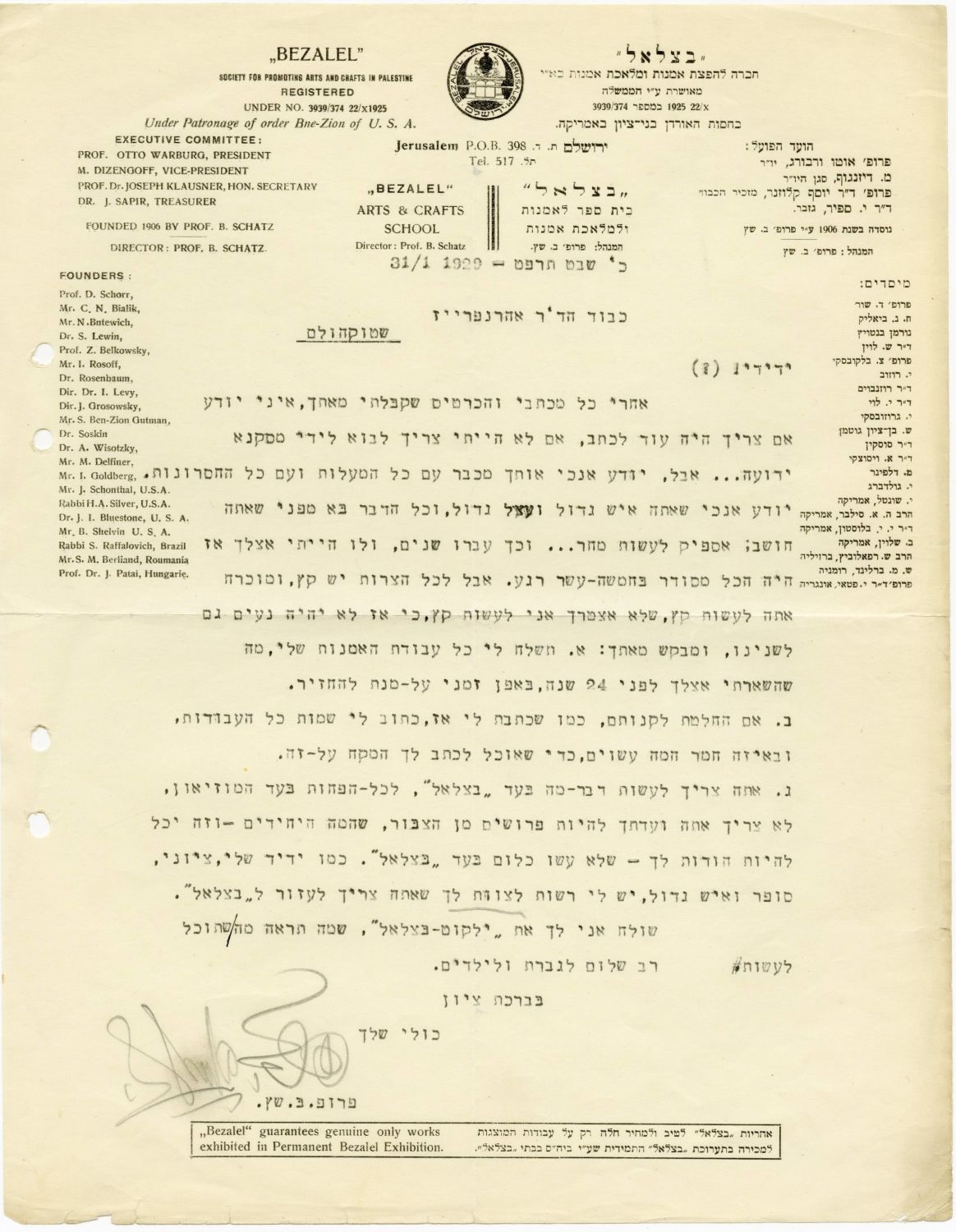
Hard and sharp letter in the handwriting and signature of Boris Schatz, director of Bezalel, dated 9/31/1929, which was sent to the Chief Rabbi of Stockholm (Sweden), Rabbi Mordechai (Marcus) Ehrenfries, in which Boris Schatz implores him to return the work of art which Left with him 24 years earlier, and that he would help Bezalel in his difficult time. The letter was written during the last dying convulsions of the Bezalel School of Art, when large parts of the school's buildings were already desolate.
"I have known you for a long time with all the virtues and all the disadvantages. I know vertically that you are a great man and a great lazy man, and all this comes because you think: I will be able to do tomorrow ... and so years passed, and if I had been with you then everything would have been arranged in fifteen minutes. All troubles have an end, and you must make an end, that I will not have to make an end, Because then it will not be pleasant for both of us either ... " . and ask him to return the work he left with him 24 years earlier, and if he decided to buy it he would detail the material from which it is made to set a price for it. Schatz also adds that he seeks the financial support of Rabbi Ehrenfreiz at least for the museum in harsh words: " You and your congregation should not be separated from the public, who are the only ones and it could be your fault - that they did nothing for Bezalel... "
[1] leaf. Official stationery of the Bezalel School with the school logo. Very good condition.
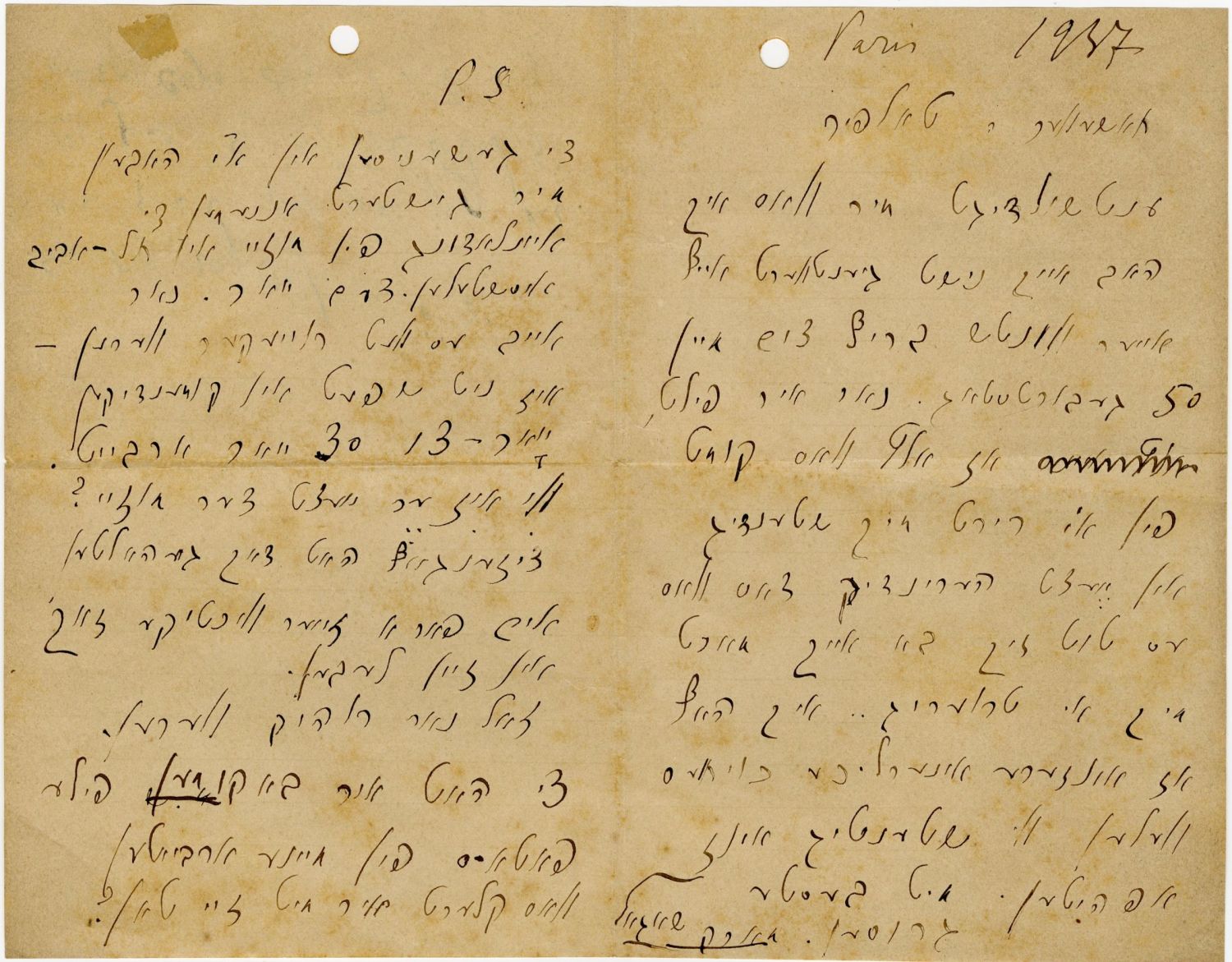
Early letter in the handwriting and signature of Marc Chagall (signed twice - full signature, and after adding a few lines in acronyms). Sent to his good friend the poet and artist Gabriel Talfir. Paris 1937. Yiddish. And rare signatures of Chagall in Hebrew.
At the beginning of the letter, Chagall apologizes for not responding to the congratulatory letter Telfir sent him on the occasion of his 50th birthday, and adds that all the letters arriving from Israel during this period sadden him (apparently following the Arab uprising that took place that year). After signing the letter, Chagall is interested in the events that took place in Tel Aviv after the death of Meir Dizengoff, and continues to ask Talfir about his actions at the time, and once again signs acronyms.
The recipient of the letter, Gabriel Talfir [1901-1990], born in Galicia, immigrated to Eretz Israel in 1925 and began writing and publishing artistic reviews on the art of painting. In 1932 he founded his art magazine "Gazit", which became the highlight of his entire artistic enterprise. Gazit magazine was for many years the only Hebrew magazine dedicated to plastic art, and Gabriel Talfir, with the help of his wife Miriam Talfir, devoted most of their efforts and resources to it. The Gazit's 32 monthly was dedicated by Talfir to Marc Chagall at the age of 90 "- 1976, pp. 377-384.
[3] pages. Stains. Good condition.
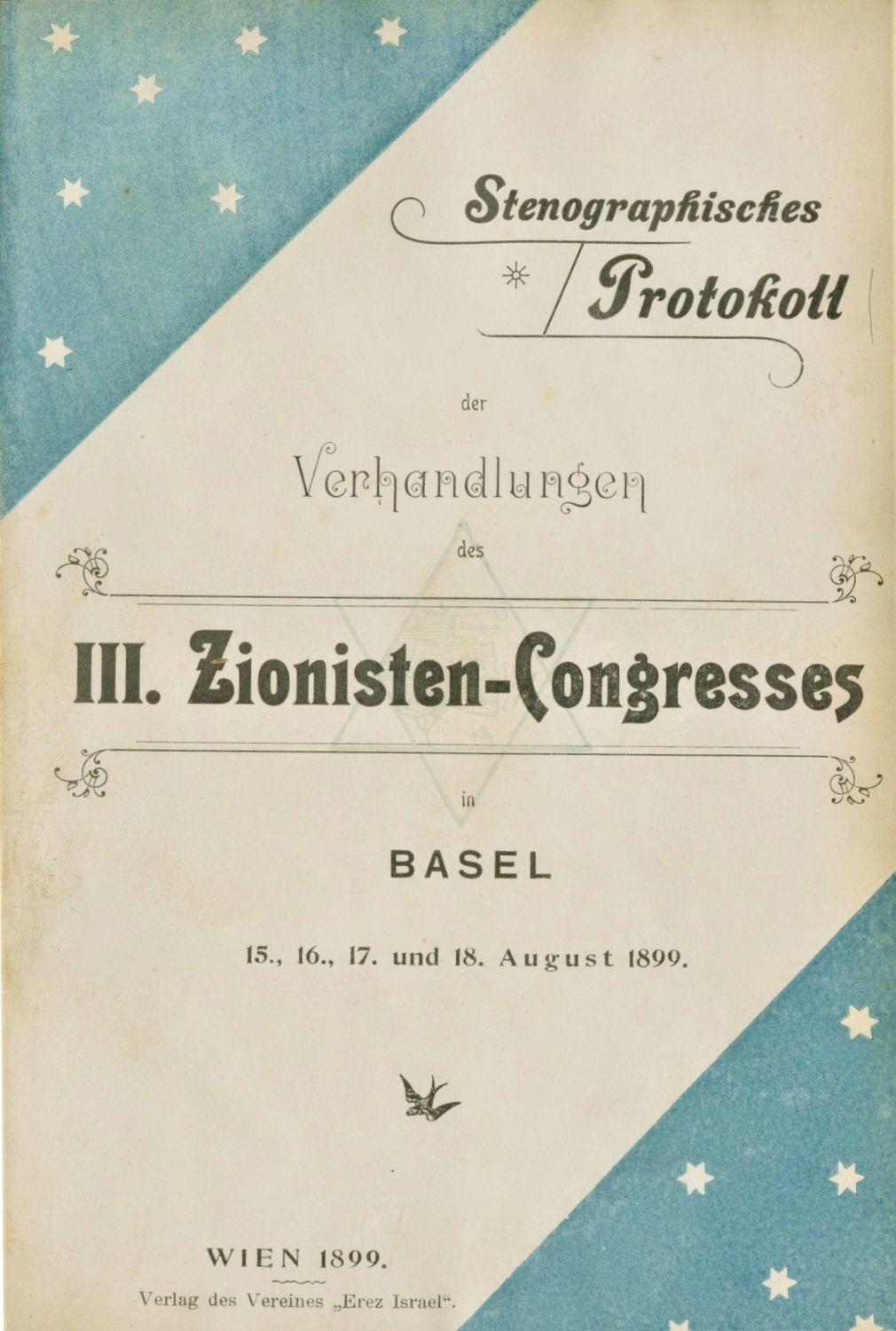
Two Minutes - Second World Zionist Congress - Basel 1899 / Fourth World Zionist Congress, London 1900.
* Stenographisches Protokoll der Verhandlungen des III. zionisten-congressess BASEL 15-18 August wien 1899 - Stenographic Minutes - Speeches by Theodor Herzl, Max Nordau, and others at the Second Zionist Congress held in Basel in 1899. Published by the Erez Israel Association, Vienna, 1899. Gilt inscription on spine. Good condition.
* Fourth Zionist congress queen's hall, london august 1900 - Report upon the status of the jews in england by l.j. greenberg, london 1900. - Speech by Leopold Jacob Greenberg at the Fourth World Zionist Congress, published by Wertheimer London. Good condition.
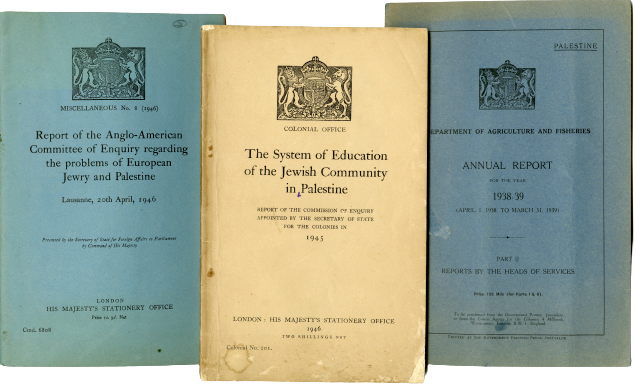
22 Reports and memoranda - The Royal Commission on Palestine (London) and the Government of Palestine. Years: 1919-1947 - (not consecutive)
Including:
Annual reports of various departments in the Palestinian government: Agriculture, Development, Demography, Transportation, Foreign Trade, Temporary Regulations, and more.
Reports of the Royal Commission on Palestine, on immigration, the Jewish education system, agriculture and fisheries, agricultural cooperation between Jews and Arabs, statistical reports, a special report on post-Holocaust European Jewry and the refugee problem (1946), Many of the reports feature various and rare maps of the Land of Israel (in one report from 1930 Six large folded maps), charts, and photographs.
The collection has not been thoroughly examined.
general condition good - very good.
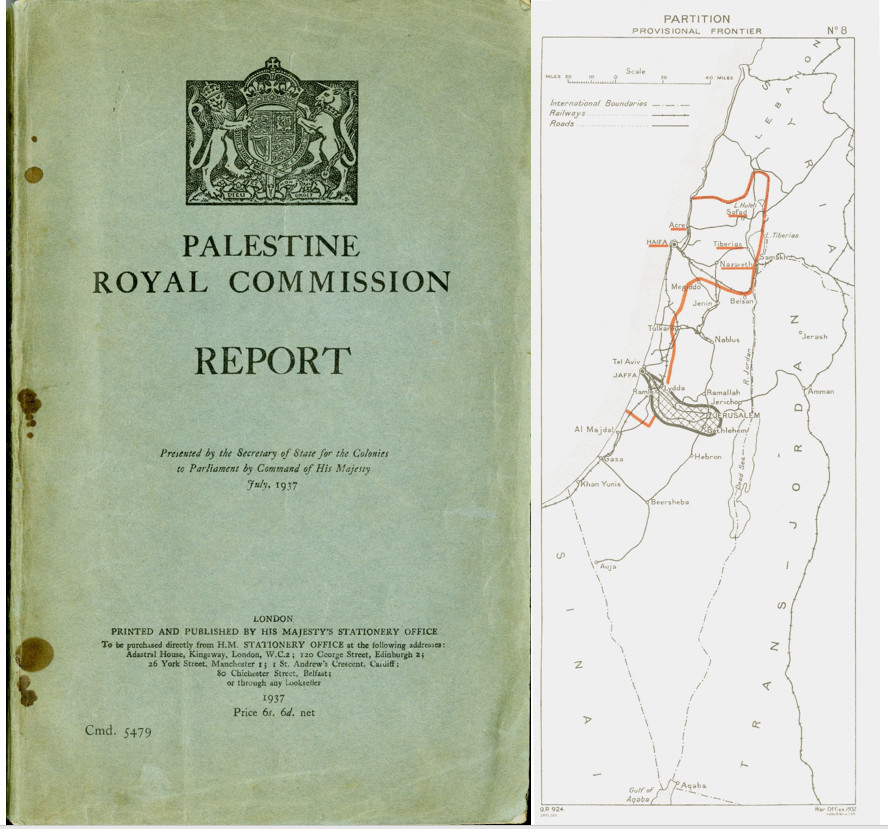
The full report of the "Royal Commission for Palestine" (Peel Commission) - accompanied by 8 maps of the division plan of the Land of Israel. London, July 1937.
Before us the full and detailed report that presents the results of the committee's research and recommendations on the main issues it sought to investigate: the reasons for the outbreak of the Great Arab Revolt, the resolution of the existing conflict between Arabs and Jews, and the functioning of the Mandate in Eretz Israel. Accompanied by 8 colorful maps of the Land of Israel with markings according to the committee's recommendations. The committee's conclusions were published in London on July 7, 1937, after holding 31 open and 48 closed meetings, and hearing about 120 witnesses - Zionist leaders in Israel, and Arab population leaders, public figures, and more. The committee decided on the division of Western Israel into two states - a decision that raised tensions between Jews and Arabs, and had widespread opposition in both populations.
404 XII pages + 8 folded maps. The back of the cover and some of the maps are detached. Rust marks near the fastening pins. Good condition.

Two Reports of the Zionist Congresses, the Fourteenth [1925], and the Eighteenth [1933].
* Financial Report of the Palestine Zionist Executive for peroid October 1922- May, 1925 The XIVth Zionist Congress - Submitted to the 14th Zionist Congress Vienna - 1925. At the Congress the criticism of the zionist leadership increased. Discussions around the economic crisis that befell the country in light of the fourth aliyah.
Report of the Executive of the Zionist Organization submitted to the XVIIIth Zionist Congress at Prague AUGUST 21st-29th 1933 - In this Congress the anthem of "HaTikvah" was officially established as the anthem of the Zionist movement. The congress was conducted under the sign of Arlozorov's assassination. During the speeches of the revisionist representatives, all the representatives of the workers' faction stood up and left the hall demonstratively. The revisionists were not elected to the presidency of the congress and their motions were not put to the vote.
Very good condition.

OST UND WEST - Illustrierte Monatsschrift fur Modernes Judentum - 'East and West' - a monthly illustrated magazine for modern Judaism, published in Berlin - a special memoir in the memory Theodor Herzl - August September 1904 - about a month after his death. The special issue deals entirely with the figure of Herzl, including rare photographs of Herzl from the early years of his life to the height of his fame in the Jewish world as a leader of the Zionist revolution. Extensive articles about him from various authors (among them: Prof. H. Vambery, William Gulbaum, and, Dr. Gestner (London), Israel Zangwille (London), Benjamin Jeff, Isidore Eliasoff, and others). Photographs of letters he wrote, as well as early articles written by Herzl himself dealing with the Jewish question, etc. Very rare (on the last page of the issue is a photograph of Herzl's tomb in Vienna - one of the first ever published in a journal).
Ost und West ("East and West") was a Zionist journal of Jewish culture and the wisdom of Israel. The magazine was published in Berlin between 1901 and 1923. The spirit of the journal was formulated by Martin Buber who advocated presenting Judaism as a culture and not just a religion and his conception of the Land of Israel was in a romantic spirit. Its founder and editor was Davis Trich and his deputy was Arthur Zilberglite. "East and West" tried to bridge between modern, Western Judaism and traditional, Eastern European Judaism.
The magazine combined works of art, mainly Art Nouveau engravings (mainly by Ephraim Moshe Lilien) with artistic and critical writing. The authors of the journal include Buber, Ludwig Geiger, Customs Nordau, Alfred Nussig, Yosef Halevi, Israel Levy, David Zvi Miller, Fabius Shach, Avraham Epstein, Adolf Rosenzweig, Arno Nadel (editor of the music supplement) and Theodor Zelocisti. The language of the journal was German and Yiddish translations were first brought in this language.The magazine appeared until August 1914 as a monthly magazine. In 1923, with the collapse of the Weimar Republic's economy, the magazine closed.
Complete sheet. Detached pages. good - moderate condition.
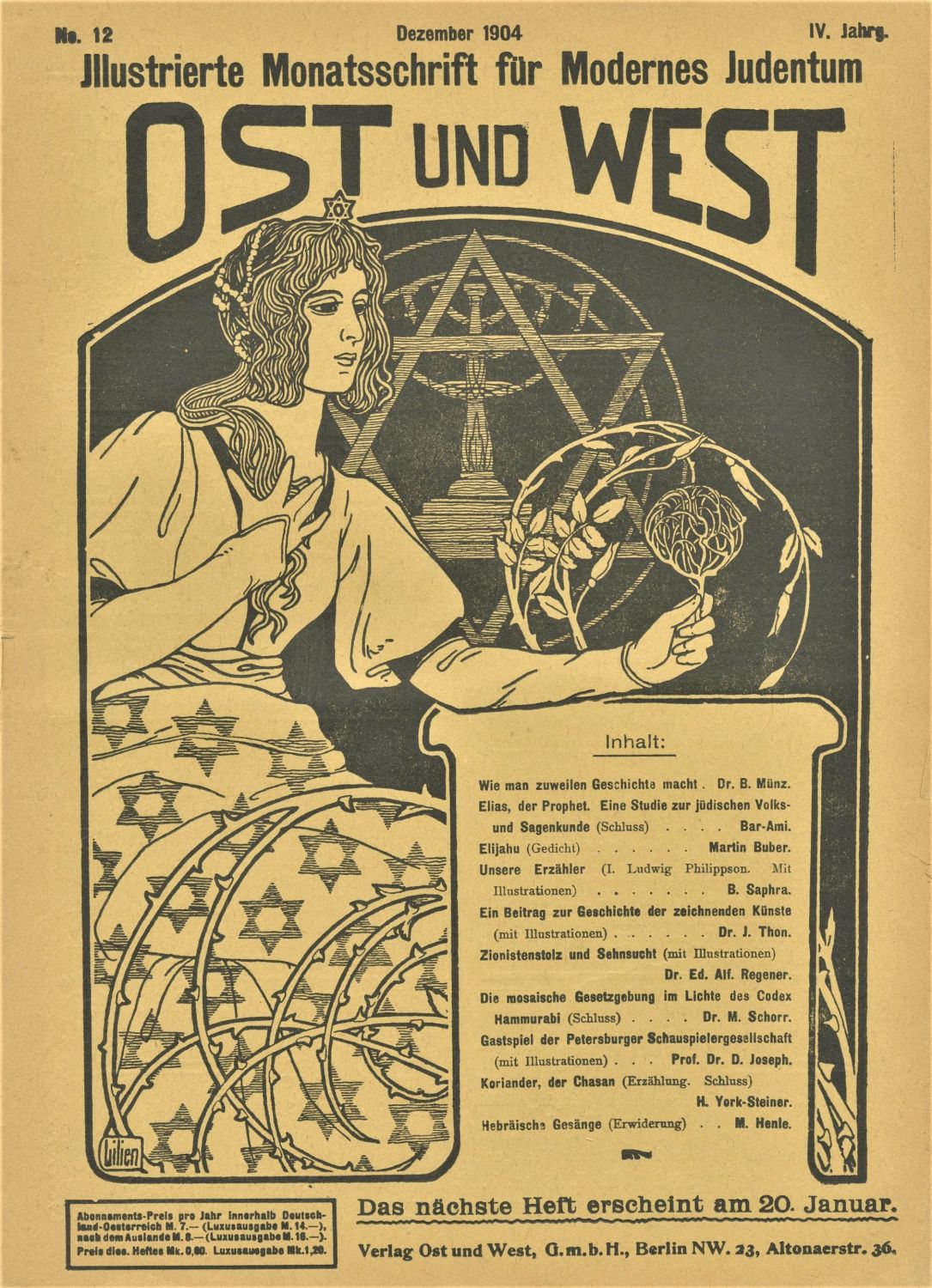
9 issues OST UND WEST - 'East and West' - Illustrierte Monatsschrift fur Modernes Judentum - illustrated monthly of all Judaism - an illustrated monthly magazine for modern Judaism published in Berlin. Issues in 1904. The covers of the issues designed by Ephraim Moshe Lillien (one of the issues in the collection Dedicated entirely to the work of Ephraim Moshe Lillian).
Before us Issues No. 1-7 (No. 7 Double), 11, 12.
Ost und West ("East and West") was a Zionist journal of Jewish culture and the wisdom of Israel. The magazine was published in Berlin between 1901 and 1923. The spirit of the journal was formulated by Martin Buber who advocated presenting Judaism as a culture and not just a religion and his conception of the Land of Israel was in a romantic spirit. Its founder and editor was Davis Trich and his deputy was Arthur Zilberglite. "East and West" tried to bridge between modern, Western Judaism and traditional, Eastern European Judaism.
The magazine combined works of art, mainly Art Nouveau engravings (mainly by Ephraim Moshe Lilien) with artistic and critical writing. The authors of the journal include Buber, Ludwig Geiger, Customs Nordau, Alfred Nussig, Yosef Halevi, Israel Levy, David Zvi Miller, Fabius Shach, Avraham Epstein, Adolf Rosenzweig, Arno Nadel (editor of the music supplement) and Theodor Zelocisti. The language of the journal was German and Yiddish translations were first brought in this language.The magazine appeared until August 1914 as a monthly magazine. In 1923, with the collapse of the Weimar Republic's economy, the magazine closed.
complete sheets. In parts detached pages. general condition good.
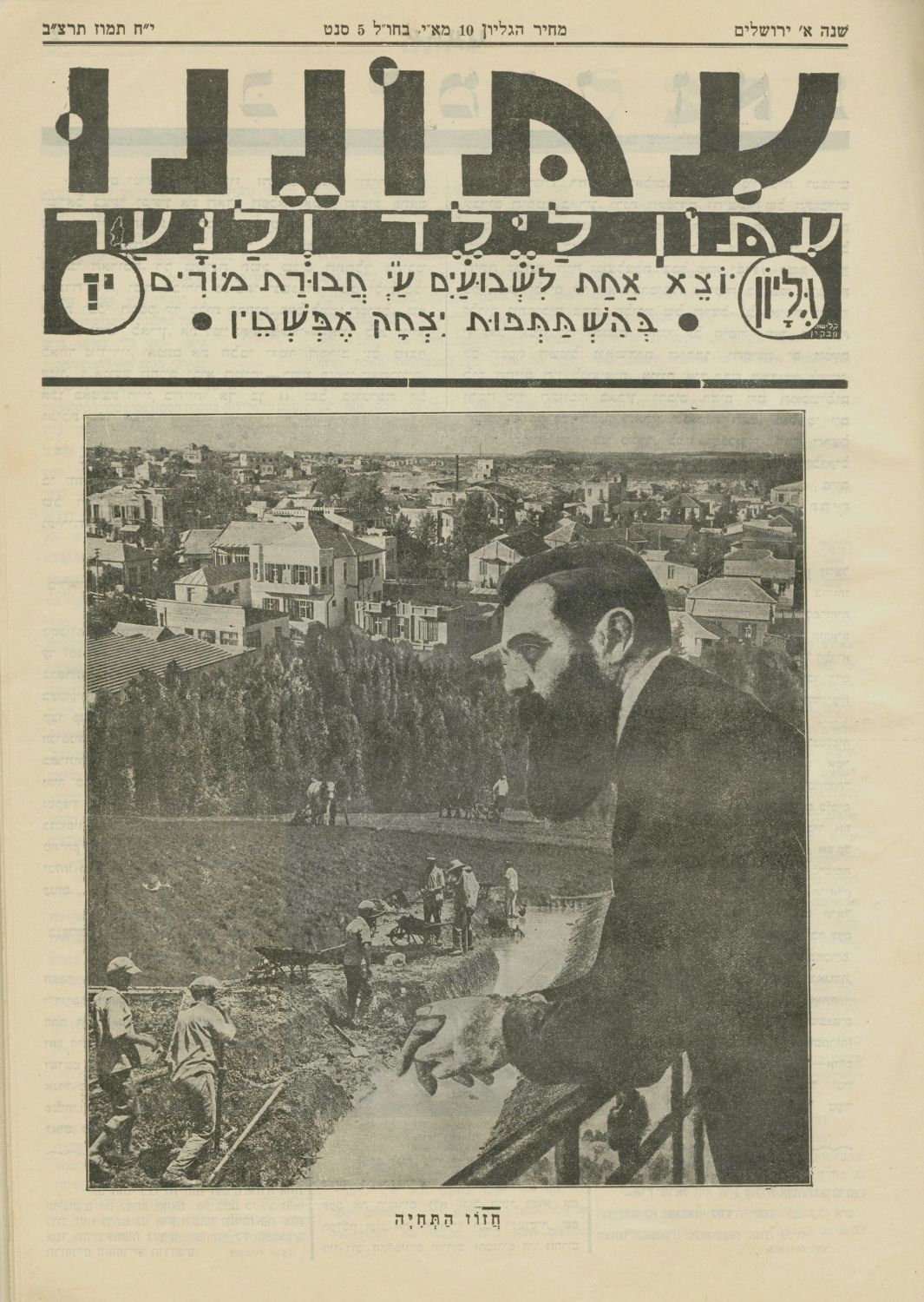
A collection of early newspaper issues for children.
* 'Itonenu' - A newspaper for children and youth - Jerusalem - published once every two weeks by a group of teachers with the participation of Yitzhak Epstein - all issues of the first year (Issues 1-23 bound) starting with the first and rare issue of Tu B'Shvat 1932. "inspection in the volumes of 'Etonenu' will reveal that it was one of the richest and most diverse in our children's magazines ... it had intimacy, soul, a cordial spiritual connection with the little readers and full identification with their world ..." (Uriel Ofek - Hebrew Children's Literature 1900- 1948, Part II, p. 594). In the sheets appeared Stories by Shaul Tchernhovsky, Levin Kipnis, Daniel Persky, David Yellin, and more Writers. Bialik published in it the series of stories 'On the Rabbit'. Most of the stories in the sequels printed in it, excelled in fascinating plots that increased readers' viewing of subsequent editions (ibid.). In Tammuz 1937 the last issues of 'Our Newspaper' came out, and the beloved newspaper was closed due to lack of budget after five years of distribution.
* 'Homateynu' (Our Wall) - Newspaper of the Youth Battalions Sukkot Eve, Jerusalem 1949 - Most of the writers were members of the youth battalions, photographs and illustrations.
* 'Hazon' - (Vision) - published by the national leadership of Mizrahi Youth - edited by Yitzhak Alfasi. sheets:
1. - Kislev 1950.
2 - Tevet 1950
5. - Sivan 1953.
6 - Tishrei 1953 - special issue for Rosh Hashanah.
2-3- (ninth year) - Shvat-Adar 1953.
general condition very good.

A special announcement to the rabbis and heads of congregations on behalf of the Chief Rabbinate prior to the declaration of independence on 5 Iyar 1948, signed [in print] by the Chief Rabbis of the Sephardic and Ashkenazi Land of Israel - Rabbi Yitzchak Isaac Halevi Herzog, and Rabbi Ben Zion Meir Chai Uziel. Typewriter printing. Extremely rare.
"To the Rabbinical Council Shlita and the Chiefs of the Communities, Councils and Localities and the Gabay of the Synagogues... Please inform the audience to gather in the synagogue as soon as Victory Day is announced (morning or evening) and to make "Thanksgiving prayer as a continuous order in it. With the blessing of the Torah and the land, and prayer for the complete redemption of Israel soon ..." and the rabbis' signatures in print. Below, the rabbis added a note: "If time is not enough, some psalms and verses can be omitted, as long as they pray the memorial service and the thanksgiving prayer."
[1] Typewriter page. 21x14 cm. Filing holes. Good condition.

"We have reached a situation where traditionally Jews do not take tefillin in the Land of Israel ...". Handwritten diary of an active in the Jewish Agency describes in detail the occurrence of the immigrants' acceptance and the various decisions regarding the aliyahs and their transfer from immigrant camps to temporary permanent buildings, in extremely difficult living and living conditions. The diary is written in sequence and describes a period of two years - between the end of 1948 and 1950. The diary does not indicate the writer's name, but according to the extensive authority arising from the detailed instructions in it, it Probably one of the heads of the Jewish Agency. (See also other parts of the diary from the same author: Dynasty auction no. 10, Item 95).
Among other things, the author details how the agency brought new immigrants to Jerusalem during heavy shelling by the Arab enemy over the city, out of irresponsibility for their fate. He goes on to describe the irresponsible settlement of immigrants in Talpiot in abandoned houses, in the German Colony in Jerusalem, in the Ein Kerem area, in the Baka neighborhood, and in Kfar Etzion, and the difficulties the immigrants went through in moving from immigrant homes to their permanent housing. The author describes: "Dozens and possibly hundreds of families suffered all winter hard of the year from infiltration and leakage of rainwater in their apartments because they did not have the amount of money the inspector demanded from them at the expense of repairs ... In my opinion this department no longer has much experience in repairing houses, and perhaps she also lacks a great desire " . There is also a detailed list of the number of immigrants, percentages of all immigrants and the place where they settled. The author notes how the decision was made regarding the housing of the immigrants: "The apartments allocated by the absorption department were divided among the immigrants according to the date of immigration. Immigrant who arrived in Israel first, was first in line to receive an apartment, A family of 2-3 people received one room. From three people or more, or there were older boys, reception 2 rooms ... " And Describes apartments with a shared kitchen that the immigrants received many times provoked quarrels due to overcrowding: "Conflicts and quarrels between the tenants often break out of the shared kitchen, and things sometimes get to dangerous proportions, to hand fights and punches, and employ the medical service and the security forces." He adds about quarrels that have taken place between kosher and non-kosher observers: "The general public has no idea what is going on in this hell called a shared kitchen. This is a serious disturbance in the acclimatization of immigrants in the country, and sometimes causes and influences the departure of the country. This is especially true of a Jew who keeps the kitchen kosher, while his neighbors do not adhere to kosher. "
The author also describes how all the doors and windows were removed in favor of using firewood, the payment terms for rent that most immigrants did not meet, a chilling description of a building in Jaffa that collapsed on its occupants in April 1950, as well as a collapse of houses in Ein Kerem in the winter after Let the tenants not know that the conditions of the houses have to be adapted to the winter. In one of the houses an entire family was evicted from their house a few hours before the whole house collapsed. The author also describes how war invalids in the War of Independence live in unbearable conditions: "We know several dozen soldiers with a war disability from among the veteran residents of Jerusalem, who in their blood saved Jerusalem, still live today in a difficult housing situation, a large family in a narrow apartment, and which affects the health of the disabled". A special chapter in the diary is devoted to the shortage of religious articles for observant immigrants. Describes how there are immigrants who stopped keeping mitzvos as a result of the shortage of religious articles: "There are some religious immigrants who have not yet set mezuzahs in their apartment. And those who do not even put on tefillin, and do not wear a tassel, because they do not have tefillin and mezuzahs. There is nothing to talk about prayer books and Chumashim or other holy books that they do not have. And these are religious Jews who in the Diaspora were from Shlomi Emunim Yisrael, observant of Torah and mitzvah, and meticulously meticulous as severely ... ", and suggests that religious organizations act on the matter. And more.
30 pages. Diary 20x14 cm. Not bound. Good condition.
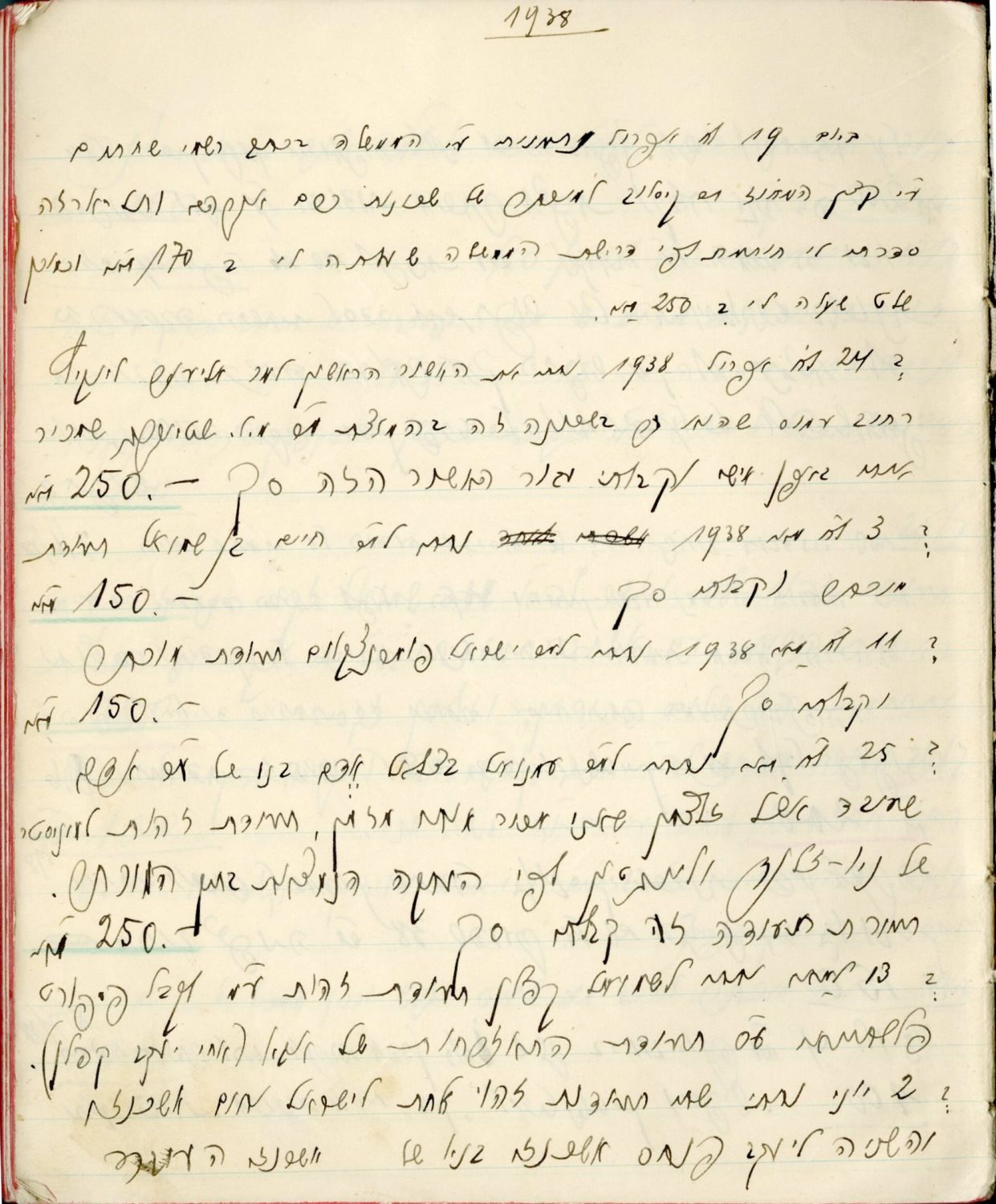
The personal notebook of the Mukhtar David Vygotsky, which was appointed by the Palestinian government for the neighborhoods of Kerem Avraham and Tel Arza in Jerusalem. In the notebook, management records written by Vygotsky between the years 1938-1947. On the cover of the notebook is the signature of Vygotsky, and after it is a page with an official note of his appointment as the crowned mayor.
In the notebook we find many names of Jerusalem residents at that time who received from Vygotsky various certificates that were distributed to citizens in those years such as: honesty certificates, identity cards, character certificates, Mukhtar certificates, certificates for obtaining citizenship, permanent residency certificates and more. He also details about various documents he signed, and interesting certificates he issued such as: "Assurance on pasting an ad for the auction of the house belonging to Eliyahu Landsa, 12 Ovadia Street", "Request and Assurance to release property tax Mr. Yitzhak Hochman who lived in the back of a restaurant owner In Mea Shearim ", "Birth certificate for Rabbi Pinchas Hamburger based on a letter from the Shomrey Hachomot Kollel from the 27th of Nisan 1939". In the notebook, hundreds of names of Jews living in the neighborhoods of Jerusalem and details about the treatment of their status by David Vygotsky.
64 written pages. Good condition.
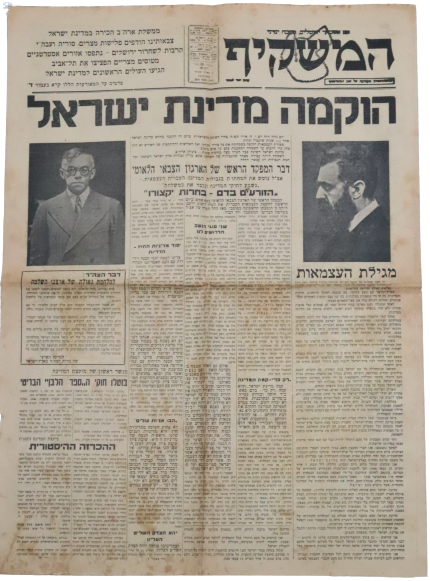
Issue "HaMashkif" - Newspaper of the Revisionist Movement in Eretz Israel, dated Sunday, May 16, 1948 - entitled: "The State of Israel was established". (The announcement took place on Friday, May 14, and the newspapers announced it two days later on Sunday)
On the first page are pictures of Herzl and Jabotinsky, the full version of the Declaration of Independence and "The Commander-in-Chief of the National Military Organization", according to which "Etzel abandons the underground within the borders of the independent Hebrew state". The upper part above reads:
"The United States government has accepted the fact of existence of the State of Israel, our armies are repelling Egyptian invasions ... battles for the liberation of Jerusalem ... the first immigrants arrived in the State of Israel."
"HaMashkif" - saw himself first and foremost as protecting the integrity of the homeland and this fact was expressed in the map of the Land of Israel, which appeared on the title page of the newspaper, and encircled both sides of the Jordan. Published in consecutive years: 1938-1949.
Complete sheet. 55X40.5 cm. Stains, folding marks. Good-moderate condition.
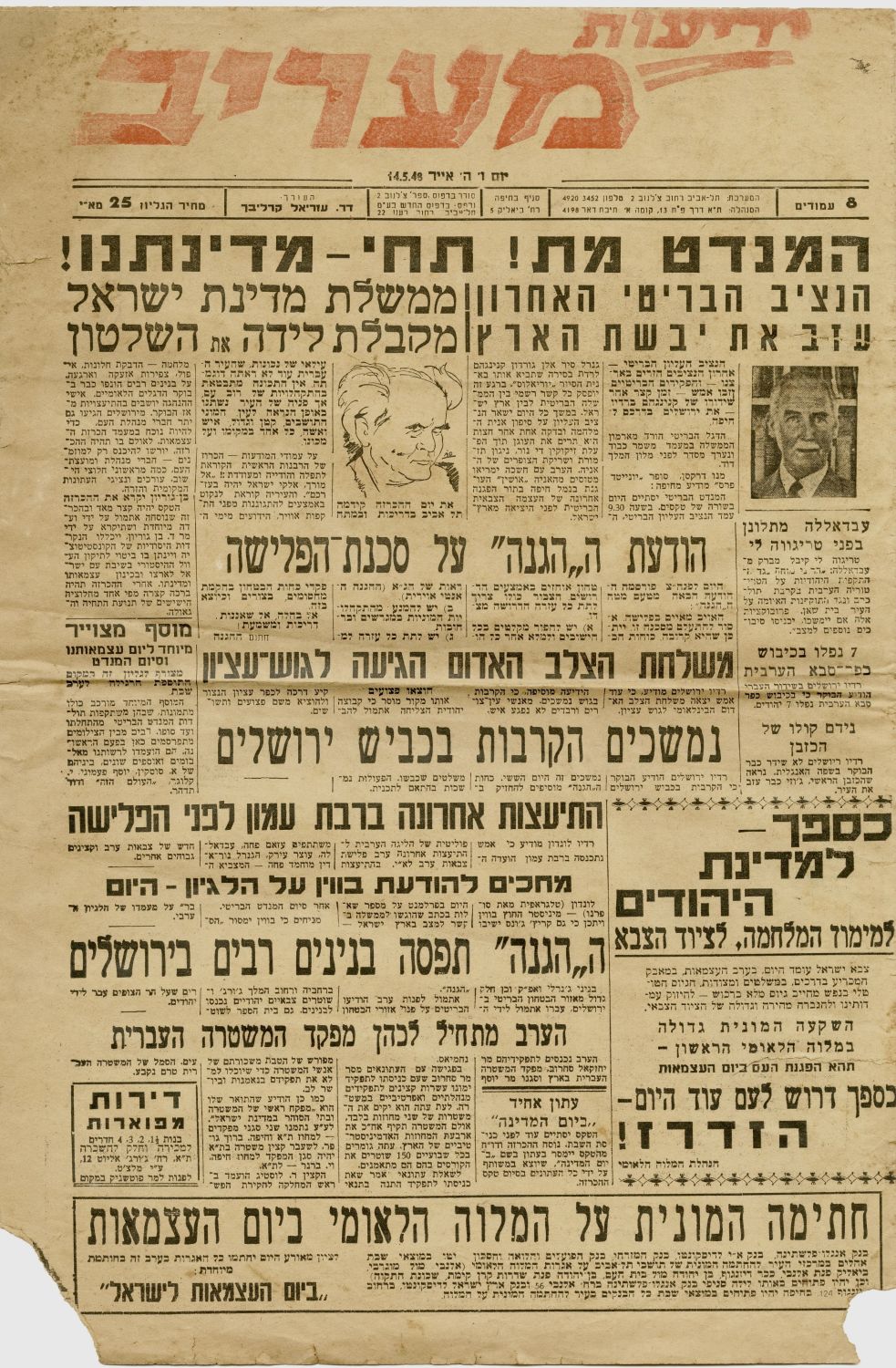
"The mandate is dead! Long live our country!" Yedioth Maariv, issue from the day of the declaration of independence of the State of Israel, 5.14.1948.
Subtitles on title page: "The last British commissioner has left the continent of the country", "The government of the State of Israel is taking over the government", "Tonight the Hebrew police chief begins to serve". And in the other pages: "Tel Aviv promotes the state! The city - in the last hours before the declaration", "London: UN will no longer be able to prevent the establishment of the Hebrew state". And a painting of the face of David Ben-Gurion. In the issue, information about the departure of the British Commissioner and the establishment of the Israeli government, along with reports of fighting in Gush Etzion, the Jerusalem Road and Kfar Saba, and more.
[4] pages, 43 cm. Missing tear in lower corners without damaging text. Stains. moderate condition.
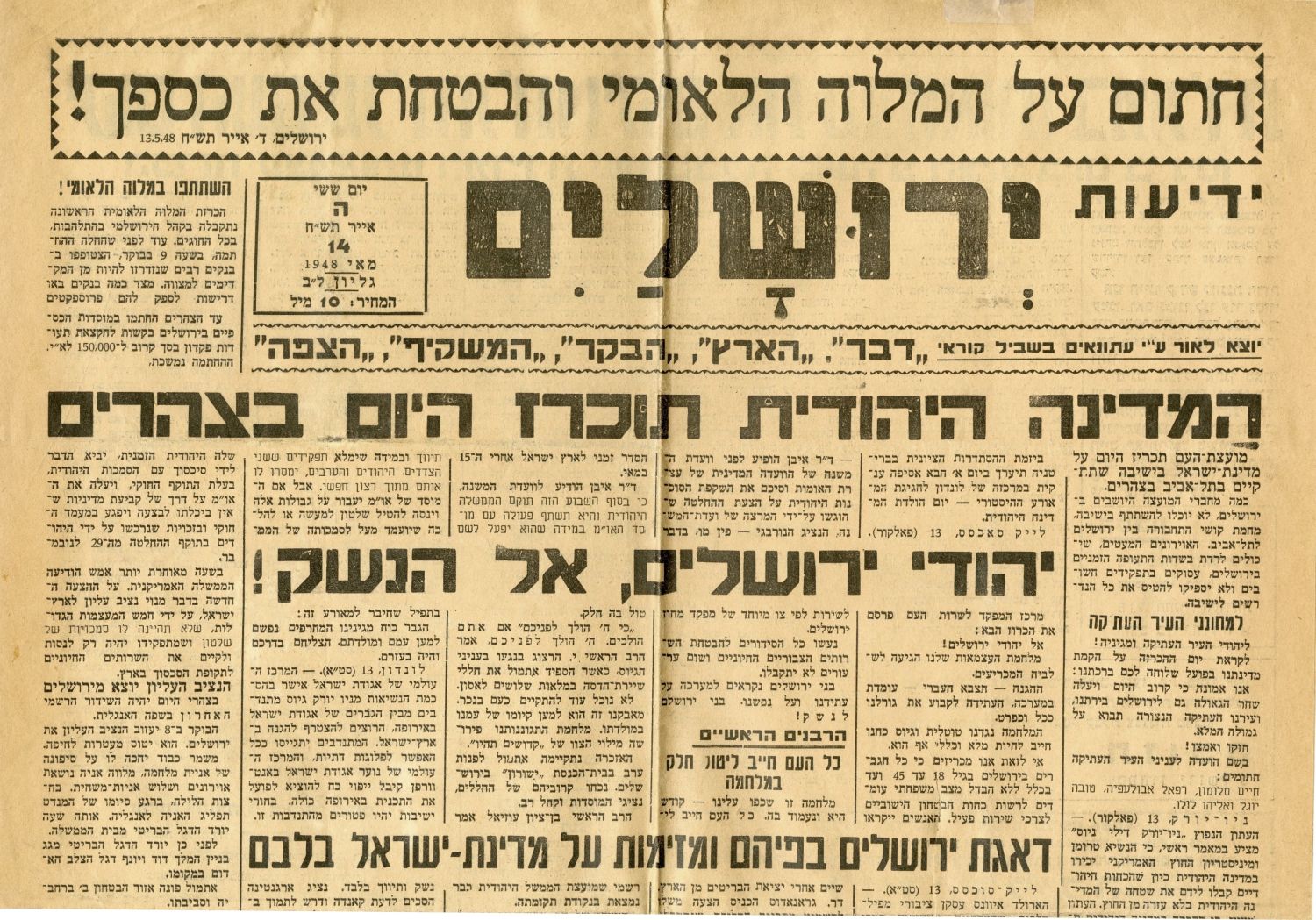
Issue of the newspaper Yedioth Yerushalayim from the date of the proclamation of the state of Israel - Its title: "The Jewish State Will Be Proclaimed This Afternoon". May 14, 1948.
A historical issue that was published on the day of the establishment of the state. the newspaper "Yediot Yerushalayim" was published by journalists for readers of "Davar", "Haaretz", "Habeker", "HaMashif", "Hatzofeh". This issue even published for the first time the wording of the Declaration of Independence under the heading: "The people will stand on their land and establish their independence in the homeland". On the title page, next to the headline announcing the declaration of the state that will take place that day, is the headline: "Jews of Jerusalem, to the weapon!" The warning about "the war against us totally and the mobilization of our power must be full and general as well".
[2] p. 50 cm. Slight tears in the upper margins. Good condition.

Issue of the newspaper 'Davar', dated May 14, 1948, entitled: "Today, the State of Israel will be declared at a solemn meeting of the People's Council".
Subtitles on the title page: "The People's Council will announce the repeal of the White Paper laws at the end of the British Mandate and give effect to all other laws in the country that exist today". The Hebrew Post Stamps were first published in this issue, and articles on the 'First Government'. And "we were like dreamers", and more.
8 p. 59 cm. Folding marks. Stains. Good-moderate condition.

"The people declare on the State of Israel." "Last day for foreign rule" - the "State Day" newspaper, a festive issue co-published by the Country newspapers in the State Declaration Day. May 14, 1948.
At the top of the issue is a picture of Theodor Herzl, in the picture below the members of the Provisional Government at its first meeting of the People's Administration. Subtitles: "On November 29, 1947, the United Nations General Assembly passed a resolution requiring the establishment of a Jewish state in Israel - and by virtue of our natural and historical right we hereby declare the establishment of a state in Israel", as well as: "All White Paper Laws Repealed" and :"The Hebrew army is expanding its conquests on State Day"
Complete issue, 2 pages. 58 cm. Folding marks, stains. condition good-moderate.
Created and Develop with 🤍By webe ©2024